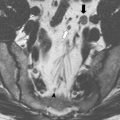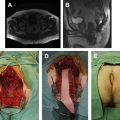Colorectal cancer rarely occurs before the age of 50. When it does, it is often advanced and aggressive. There may be predisposing genetic and immune factors that lead to its origin. Genetic counseling is indicated for all patients younger than 50 with colorectal cancer. Before surgery, the tumor and the patient must be evaluated as fully as possible, so that optimal treatment, follow-up, and surveillance are used.
Colorectal cancer occurs because of an accumulation of genetic abnormalities in a line of colonocytes that are usually the result of many years of exposure to environmental carcinogens. The genetic abnormalities produce cells that are capable of escaping controls on growth, death, and differentiation, and these cells are able to travel from their site of origin and establish viable colonies in distant locations. For cancer to develop, the neoplastic cells must also overcome the defense mechanisms of the host, which often recognize them as foreign and try to destroy them. The timing of the appearance of colorectal cancer is therefore the result of a balance of tumor factors and patient factors.
Colorectal cancer does not arise de novo from normal epithelium. There is a polyp-cancer sequence, the histology of which depends on the underlying genetic changes in the epithelial cells. Widespread mucosal methylation produces a serrated polyp-carcinoma pathway, but an adenoma-carcinoma sequence is the most common way in which the effect of accumulating mutations is expressed. For sporadic cancers, the time between the appearance of an adenoma and the change into carcinoma is approximately 10 years.
The median age at diagnosis for colorectal cancer in the United States is 70 years, reflecting the overall time it takes for carcinogenesis to occur. A young age at diagnosis suggests rapid carcinogenesis and is rare; approximately 5% of patients with colorectal cancer are diagnosed at age less than 45 years. A younger age at diagnosis is rarer, with 0.1% of all colorectal cancers diagnosed at age less than 20 years, 1.1% between 20 and 34 years, and 3.8% between 35 and 44 years. A further 12.4% are diagnosed between 45 and 54 years. The accelerated carcinogenesis in these young patients may be caused by one or more of several possible factors, including particularly powerful environmental carcinogens, a particularly weak host response, and the inheritance of a germline mutation in a key tumor suppressor gene. When a young patient presents with a colorectal cancer, consideration of all these possibilities is helpful.
Biology of colorectal cancer in young patients
Many articles describe groups of young patients with colorectal cancer. O’Connell and colleagues performed a thorough literature search and reviewed 55 reports mostly defining young as less than 40 years of age. Some interesting facts emerged. Although there was no difference in the proportion of men or women affected, African Americans were overrepresented in the young cancer group. Almost a quarter of the patients had a family history of colorectal cancer (22.7%, compared with 28.8% in a study of patients between 30 and 70 years of age ), and a further 16% had other predisposing factors, such as inflammatory bowel disease, hereditary colorectal cancer syndromes, and a family history of primary cancers in other organs. Delay in diagnosis was common in patients with colorectal cancer diagnosed at age less than 40 years and averaged a little more than 6 months. Most cancers were left sided (67%), and 66% were Dukes stage C or Turnbull stage D. There was a high incidence of mucinous tumors (21%) and poorly differentiated tumors (27%). Resectability rate was 86%, and 5-year survival rates were 94% (Dukes A), 76.5% (Dukes B), 39% (Dukes C), and 6.8% (stage D).
In a different study, the same authors reviewed the Surveillance Epidemiology and End Result (SEER) national database and compared patients with colorectal cancer who were aged between 20 and 40 years at diagnosis with those aged between 60 and 80 years. Again, young patients were more often African American (16.4% vs 9.0%) and had tumors that were of more advanced stage (stages III and IV, 56% vs 41%) and more often poorly differentiated (27.3% vs 17.2%). Despite this, 5-year survival for stages I and III were similar between the 2 age groups, whereas survival after resection of stage II and IV cancers was better in young patients. There were no family history data available in the SEER database. There are thus several features of colorectal cancer in young patients that potentially affect diagnosis, workup and management.
Advanced Stage at Diagnosis
One obvious reason for the advanced disease that characterizes colorectal cancer in young patients is delay in diagnosis. Unless there is a family history, these patients are not screened, so cancers are usually symptomatic at presentation. Even when symptoms occur, they may be initially misdiagnosed. Rectal bleeding, for example, is often put down to an anorectal cause. O’Connell and colleagues reported an average delay in diagnosis of 6.2 months, the reasons for which included a delay in presentation on the part of the patient, limited access to care, and misdiagnosis on the part of the physician. Minimizing delay in diagnosis means not taking symptoms lightly. Outlet-type bleeding usually has an anal cause, but when no anal cause is obvious and the bleeding persists, colonoscopy is mandatory, regardless of the patient’s age. Abdominal pain is not usually a presenting symptom of colorectal cancer, nor is change in bowel habit. However, symptom persistence and the lack of a convincing alternative explanation for the symptoms demand further investigation.
Family History
A family history is an important part of the evaluation of each and every patient. Historically, physicians perform badly in the proportion of patients queried, and the overall sensitivity of a family history of colorectal cancer varies from 0.6 for first-degree relatives to 0.3 for second degree. However, despite limited accuracy and compliance, family history is still the most easily obtainable risk factor for colorectal cancer; a thorough family history is essential. Each generation is asked for specifically, and lack of knowledge is not equated to a knowledgeable “No.” Any abdominal cancers, colonic polyps, need for a stoma, and extra-abdominal cancers, such as those of the uterus, ovary, liver, and small intestine, are queried for. A cancer-prone family may not fit any of the commonly recognized syndromes but may be at high risk of colorectal cancer nonetheless. When the proband is young and has a colorectal cancer, a weakly positive family history is viewed with suspicion and a strongly positive family history of colorectal cancer is a clear indication of an inherited syndrome. The absence of polyposis and presence of a right-sided tumor suggest Lynch syndrome (hereditary DNA mismatch repair deficiency). It is important to diagnose this syndrome for several reasons. Firstly, the best surgical option in a patient with Lynch syndrome and a cancer is colectomy and ileorectal anastomosis, which is to prevent metachronous cancers. Secondly, patients with Lynch syndrome are at risk for cancers of other organs, making surveillance a consideration and raising the possibility of prophylactic hysterectomy and oophorectomy. Thirdly, patients suspected of Lynch syndrome can be offered genetic testing, which would establish the diagnosis, allow focused surveillance depending on the gene carrying the mutation, and make genetic analysis available to at-risk relatives. Young patients with colorectal cancer benefit from a consultation with a genetic counselor, who can take an accurate family history and make recommendations for genetic testing.
Colorectal cancer arising at a young age is a risk factor for the family of the patient. Johns and Houlston performed a meta-analysis of 27 case-control and cohort studies of colorectal cancer risk and found that a family history of 1 affected first-degree relative who was diagnosed before the age of 45 carries a 3.87-fold (95% CI, 2.40–6.22) increased risk for the disease. Colonoscopic surveillance is recommended starting 10 years before the age of the youngest affected relative and is continued at 5-year intervals, or sooner if a polyp is found.
Other Predisposing Factors
Obvious factors such as chronic colitis and familial polyposis are relatively easily identified, and the patients may be managed by surveillance or prophylactic colectomy. MYH-associated polyposis (MAP), however, is sometimes not clinically obvious. This syndrome of mild or attenuated polyposis is recessively inherited, and therefore, family history may be weak or absent. The number of synchronous adenomas or serrated polyps may be few, and so the syndrome may go undiagnosed. A proportion of young patients with colorectal cancer have MAP. The tumors are microsatellite stable. Genetic testing should be considered.
Deficiencies in host response to carcinogenesis are less-easily recognized and less-easily treated. A personal history of other cancers, especially immunosensitive cancers such as melanoma, if occurring at a young age, may indicate an increased susceptibility to colorectal cancer. Chronic immune suppression or clinical suggestions of impaired immunity may also mean the same.
Advanced Biology
The advanced stage at presentation of many colorectal cancers in young patients is not just a result of a delay in diagnosis. The high proportion of mucinous and signet ring cell cancers suggests a disproportionate number of methylator tumors in this group. The poor differentiation is typical of mutator tumors. There are no data to support these conclusions, but such data are important, as they may influence the use of chemotherapy in the high proportion of cancers that have metastasized. The paradoxical good survival for patients with young age at diagnosis of colorectal cancer supports the idea that many cancers are microsatellite unstable, as this is the most common scenario in which survival after colon cancer resection is better than expected for grade and stage. However, crude survival is expected to be better than usual in young patients because of their youth and the improved tolerance of surgery and complications that this youth confers.
Stay updated, free articles. Join our Telegram channel

Full access? Get Clinical Tree





